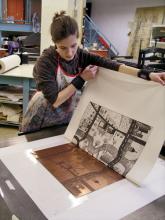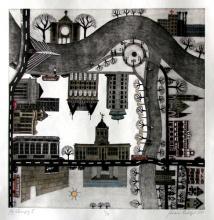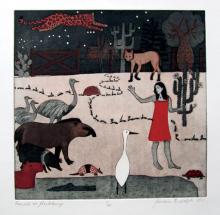Growing up, Miriam Rudolph always said she wanted to be an artist . . . or a gardener. Now, only 28 and working as a full-time printmaker, she gets to live out one of her childhood dreams.
Unsure when her creative drive began, Rudolph believes she always had an intrinsic desire to create. Her parents, both teachers, encouraged that desire, and a steady stream of art supplies for her mother’s early childhood education class gave her lots to work with.
Rudolph started painting in high school, but discovered and fell in love with printmaking while working on her fine arts degree at the University of Manitoba. After her first degree, she moved on to study education while working at printmaking on the side. And while some people might have given up on art as a career after getting her degree, she says she “decided to continue with my own artwork instead of applying for jobs.”
Her choice seems to have paid off. In 2011 alone she’s had one solo exhibition at the Martha Street Gallery in Winnipeg, Man., and has been part of several group exhibits, including one of Canadian printmakers in Washington, D.C.
While those experiences stand out as highlights of her career, Rudolph’s art is also a personal form of diary, expressing her experience of place. “Somehow I always feel I live in multiple worlds and underlying my work lies a search for belonging,” Rudolph says. And given her experience growing up in Paraguay, living in Germany and then moving to Winnipeg, that search for a home makes sense.
In fact, cartography features prominently in most of Rudolph’s work. Full of landmarks and mapping symbols, her art is tied to a personal experience of locations. The idea for that mapmaking style began after she moved to Winnipeg and had difficulty with a sense of direction, likely due to growing up in the Southern Hemisphere.
“I had the sense that the sun rises in the west and goes down in the east,” she says. “Star constellations appeared on their heads and I would instinctively turn 180 degrees in the wrong direction at every intersection.”
Now she creates art that helps her hold on to places, including memory maps of Paraguay or places she feels connected to in Winnipeg.
Alongside themes of place, Rudolph is also influenced by artists like Warrington Colescott, Marc Chagall, Paul Klee, and Frida Kahlo with her diary-esque paintings.
Although she’s recognized as a Mennonite artist, Rudolph struggles with the term because her faith has little influence on her current art. She has done some work for a chapel and a church, but finds that visual art still isn’t as important to Mennonite communities as music. “I think underlying the Mennonite culture is still the notion of simplicity and unadornment, and I don’t fit in there,” she says. “I don’t like plain white walls, except to hang my work.”
As a self-employed artist, Rudolph sometimes experiences an accompanying lack of motivation, but most days she loves going to work at the Martha Street Studio, a communal space available for Winnipeg artists to rent. She still enjoys teaching and leading printmaking workshops at the studio, but says that “at this point I can’t really see myself as a full time high-school teacher. Being able to live as an artist, I love it.”
Visit Rudolph’s website, miriamrudolph.com, for more about her work.
Know other artists, visual, musical or otherwise, that Young Voices should write about? Write to Emily Loewen at eloewen@canadianmennonite.org.





Add new comment
Canadian Mennonite invites comments and encourages constructive discussion about our content. Actual full names (first and last) are required. Comments are moderated and may be edited. They will not appear online until approved and will be posted during business hours. Some comments may be reproduced in print.